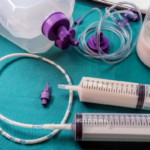Suprapubic Catheters: A Quick Guide for Patients and Caregivers
Bladder issues can be challenging, and for some patients, a suprapubic catheter (SPC) offers an effective solution when traditional urethral catheterization isn’t suitable or comfortable for long-term use. If you or a loved one are considering or already using a suprapubic catheter, this guide will assist with the process.
What is a Suprapubic Catheter?
A suprapubic catheter, or an SPC, is a thin, flexible tube that carries your urine straight out of your bladder through an opening in your lower abdomen, below your belly button. Suprapubic catheters differ from urethral catheters inserted via the urethra because they provide a percutaneous path to the bladder, which many patients may find preferable, more comfortable, and more convenient to live with.
The SPC is held in place by a small balloon inflated inside your bladder after it’s put in. This prevents the catheter from falling out but makes it easy to change when needed.
Why Would Someone Need a Suprapubic Catheter?
There are several reasons why your physician might recommend a suprapubic catheter:
- Urinary incontinence: When you’re having trouble controlling bladder function
- Urethral trauma or injury: When the urethra is obstructed or unable to pass urine
- After certain surgeries: Particularly pelvic or urologic surgery
- Need for catheterization long term: For chronic bladder drainage requirements
- Sexual activity: SPCs allow sexual activity, unlike urethral catheters
- Comfort: Suprapubic catheters are more comfortable for many than urethral catheters
- Patients who use wheelchairs: May be easier to care for by those with limited mobility
- Less risk of infection: SPC users generally experience fewer urinary tract infections than urethral catheters
In the case of patients suffering from conditions like multiple sclerosis, spinal cord injury, prostate disease, or pelvic organ prolapse, a suprapubic catheter presents a solution to their bladder issues.
The Suprapubic Catheter Placement Procedure
Placement of a suprapubic catheter is typically a rapid process. While every clinician’s placement process may vary, here’s what you can generally expect:
Before the Procedure
Your doctor can take imaging studies such as ultrasound or x-rays to confirm that it is safe to insert the catheter. This is to ensure there are no loops of intestine positioned between your bladder and abdominal wall.
During Insertion
Your doctor will start by cleaning and numbing the area. Some doctors do this differently, but they’ll make a small cut to reach your bladder and put the catheter in place. The catheter has a tiny balloon that gets filled with water once it’s inside the bladder – this keeps it from falling out. Your doctor will likely put in a stitch to hold everything in place and cover it with a bandage. Most patients see urine draining right away. Remember that your doctor might use a slightly different method based on their practice and what works best for you.
After Placement
Once you’ve had your initial suprapubic catheter placement, you might feel some pain at the insertion site. This should improve within two weeks as the site heals. Your healthcare staff will instruct you on caring for the catheter and collection system before returning home.
Living with a Suprapubic Catheter
Following your SPC placement, you’ll have two main options for collecting urine:
Free drainage system – Urine drains continuously from your bladder into a collection bag, which may be:
- A leg bag worn under clothing during the day
- A bigger night bag for use while sleeping
- A belly bag worn around the waist
Catheter valve – Works like a switch that can be turned on to drain urine straight into a toilet or collection bag so that the bladder fills naturally between draining.
Daily Care and Maintenance
Correct maintenance of your suprapubic catheter is essential to prevent complications:
- Ensure the area is as clean as possible: Clean the area in which the catheter was placed with mild soap and water daily
- Monitor signs of infection: Look for redness, swelling, pain, or drainage around the catheter
- Secure the catheter: Secure the catheter with medical tape or a catheter fixation device to prevent pulling
- Empty collection bags frequently: Collection bags should be emptied frequently to avoid infection and other complications
- Flush your catheter: Use your provider’s guidelines for keeping the tube open
Changing Your Suprapubic Catheter
Suprapubic catheters must be changed regularly. The initial change is usually done by a health professional at the hospital or clinic where it was placed.
Subsequent catheter changes can be done by:
- A healthcare worker in a clinic
- A home health nurse in your house
- You or a family member after adequate training
If the suprapubic catheter becomes dislodged, it’s important to have an additional device available or seek medical attention right away since the opening will close within a few hours.
When to Call Your Healthcare Provider
Call your doctor or nurse if you have:
- Fever over 100.5°F
- Continued leaking around the catheter
- Pain or tenderness in your stomach
- Blood in your urine greater than 24 hours after a catheter change
- Little or no urine flowing into the collection bag
- The catheter comes out and a replacement isn’t immediately available
- Signs of infection at the insertion site where the catheter is placed
Life with a Suprapubic Catheter
Having a suprapubic catheter does not stop you from leading an active, productive life. The following is some information on daily living:
- Set a Routine: Most daily activities can be maintained with good care of the catheter
- Dress comfortably: Dress in clothes that give easy access to the catheter
- Plan ahead: Find out bathroom locations when away from home
- Be positive: Join support groups of individuals with suprapubic catheters
- Follow up regularly: Attend regular appointments with your healthcare professional
Final Thoughts
A suprapubic catheter can make a big difference in quality of life for many individuals with bladder problems. Though it does take some adjustment and maintenance, most patients find that the advantages far outweigh the difficulties. By learning about the functions and proper care of your SPC, you can effectively manage your bladder health with ease and comfort.
If you are unsure about your existing catheter, talk to your doctor to find if a suprapubic catheter is right for you. For more information about catheter care or our MiniSPC®, click here.
Disclaimer: Anything contained in this blog is general information only and is not, nor should it be interpreted to be, medical advice. Always consult with a qualified physician and/or a health care provider for medical advice.


